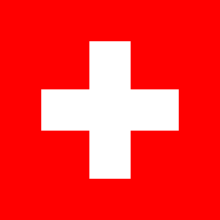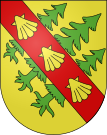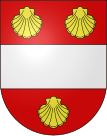List of local coats of arms with the scallop shell in Switzerland
This article contains the list of municipal coats of arms with the scallop shell in Switzerland .
As scallops or scallops are two closely related species of mussels referred both to the genus Pecten belong. The name scallop goes back to Saint James , the patron saint of pilgrims , whose distinguishing mark is the shell.
Kanton Aargau
The canton of Aargau ( French Argovie , Italian Argovia , Rhaeto-Romanic Argovia , Swiss-German Aargou ) is a German-speaking canton in northern Switzerland. The main town is Aarau .
On red a white scallop shell with pierced wings.
Explanation: The scallop is a reference to the numerous pilgrimage routes to Santiago de Compostela, one of which led via Buttwil . The name of the hamlet Galitzi (for Galicia ) also reminds of this . Until 1957, the congregation had used the torture column of Christ as a coat of arms , but historically it stands for the entire free offices.
Canton of Friborg
The canton of Friborg ( French Friborg , Italian Friburgo , Rhaeto-Romanic Friburg , Swiss German Frybùrg ), officially the state of Friborg and État de Friborg , is a French- and German-speaking canton in the west of the country. The main town is Freiburg .
The upper half shows a black horse's head on gold. A golden harrow and two scallops are depicted in red on the lower half.
Canton of Geneva
The French-speaking canton of Geneva ( French Genève , Italian Ginevra , Romansh Genevra , Swiss German Gänf ), officially the republic and canton of Geneva, is located in the south-west of Switzerland; The capital is Geneva .
canton of Grisons
The German, Rhaeto-Romanic and Italian-speaking canton of Graubünden ( Rhaeto-Romanic , Italian Grigioni , French Grisons , Swiss-German Graubünda or Bündnerland ) is the largest canton of Switzerland, its southeastern part and lies entirely in the area of the Alps . The main town is Chur .
In gold (yellow) the striding Saint James in a blue robe, with a pilgrim's staff
Explanation: The coat of arms shows the patron of the Reformed Church Bever in the swapped colors of the Upper Engadin district.
Three golden (yellow) shells in red
Explanation: The village church is consecrated to St. James the Elder; its attribute is the scallop shell.
A continuous silver cross in red, with two shells at the top
Explanation: The shells are gifts from St. James [d. Ä.], Patron of the parish church of Samnaun-Compatsch, patron of the community of Samnaun. The cross is a reference to the border community of Samnaun.
In green, an overturned golden key placed at an angle to the left with the key bit turned to the left, accompanied by two golden shells
Explanation: The motifs of the coat of arms in the colors of the Trivulzio represent the double patronage of the parish church. The key represents St. Peter , while the shells symbolize St. James the Elder.
Canton lucerne
The canton of Lucerne ( French Lucerne , Italian Lucerna , Rhaeto-Romanic Lucerna , Swiss German Lozärn ) is a German-speaking canton, the greater part of which, geographically speaking, belongs to the plateau of Central Switzerland . Its main town is Lucerne .
Canton of Nidwalden
The canton of Nidwalden ( French Nidwald , Italian Nidvaldo , Rhaeto-Romanic Sutsilvania , in local dialect Nidwaudä, officially and historically also Unterwalden nid dem Wald ) is a German-speaking canton of Switzerland, which together with the canton Obwalden formed Unterwalden , one of the three original cantons of Swiss Confederation from 1291. The main town in the canton of Nidwalden is Stans .
A silver wavy bar in red, above a silver, three-tower, tinned castle with a golden roof on the side towers, in the lower half of the shield a silver shell
Explanation: The Beckenried coat of arms dates from 1883 and is a design by the Stans heraldry Adalbert Vokinger. The silver castle is intended to commemorate the two castle locations Isenringen and Retschrieden in Beckenried. Robert Durrer writes in his booklet about the municipal coats of arms of Unterwaldens (1918): “The shell is taken from the family coat of arms of the old local family Amstad, because postman Jakob Amstad took the initiative to adopt this coat of arms and took over the costs of the design and has been one for half a century The private seal of a mayor from this family that remained on the parish chancellery had represented the role of the parish seal. "
In the red field three silver (white) scallops
Explanation: The coat of arms was created in 1901 by Robert Durrer. The shells allude to the main patron of the old parish church, the Apostle Jacob the Elder. Robert Durrer had suggested a wreathed cow with a driving bar as a variant to the Emmettern, which he personally favored because it would have heraldically fixed the old symbol of the canton of the “cow from Unterwalden”. But with that he was not heard by the local council.
Canton of Schwyz
The canton of Schwyz ( French Schwytz or Schwyz , Italian Svitto , Romansh Sviz ) is a German-speaking canton in Central Switzerland; its main town is the municipality of Schwyz .
Explanation: The two ravens in Feusisberg's coat of arms are reminiscent of the legend of the monk Meinrad von Einsiedeln († 861), the white scallops symbolize the church patron, James the Elder.
Canton of Thurgau
The Canton of Thurgau ( French Thurgovie , Italian Turgovia , Rhaeto-Romanic Turgovia , Latin Thurgovia ) is a German-speaking canton in northeastern Switzerland. The capital of the canton is Frauenfeld .
A red sloping bar with three silver shells on gold
Explanation: The colors red, yellow and white can be explained with the affiliation to the Tannegger office. And the mussels? Originally, pilgrims who visited the tomb of the apostle Jacob carried such shells on them; sewn onto clothes, they became the general hallmark of pilgrimage. After the Fischingen Monastery was founded in 1139 by the Bishop of Konstanz, the old pilgrimage route led from Konstanz via Sirnach and Fischingen to Einsiedeln. Since Sirnach was also a pilgrimage station, there is a connection between the shells in the coat of arms and the custom of the pilgrim.
Canton of Vaud
The canton of Vaud ( French Vaud , Italian Vaud , Romansh Vad ) is a French-speaking canton in the west of the country; The main town is Lausanne . The canton is known as the Vaud or also as the Vaud , in the French Pays de Vaud . The inhabitants are known as Vaudois, in French as Vaudois .
Canton of Valais
The Wallis ( French Valais , Italian Vallese , Rhaeto-Romanic Vallais , Arpitan / Franco-Provencal Valês ), officially the state of Wallis and État du Valais, is a French- and German-speaking canton in southwestern Switzerland. The main town is Sion .
See also
- List of noble and family coats of arms with the scallop in Switzerland
- Christian symbols in heraldry
Individual evidence
- ^ Joseph Galliker, Marcel Giger: Municipal coat of arms of the Canton of Aargau . Lehrmittelverlag des Kantons Aargau, book 2004, ISBN 3-906738-07-8 , p. 138 .
- ↑ See German website (heading) of the canton of Friborg. In: fr.de, accessed on September 30, 2017.
- ↑ See the French-language website (heading) of the Canton of Friborg. In: fr.de, accessed on September 30, 2017.
- ↑ The Emmetter coat of arms. In: emmetten.ch, accessed on March 15, 2015.
- ↑ The spelling with tz is used by the Guide du Typographe romand and is therefore often found.
- ↑ Sirnach community: The coat of arms. In: sirnach.ch, accessed on September 30, 2017.









































